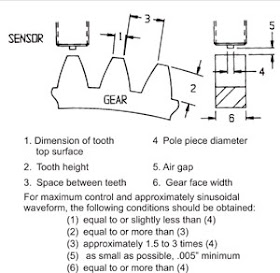 |
| Figure 1 Internal Configuration of Typical Sensors |
Principles of Operation
The internal construction of the typical Al-Tek variable reluctance
sensor is a magnet, pole piece and coil (See figure 1). A magnetic field (lines
of flux) extends from the magnet, through the pole piece and coil out into the
air space at the end of the sensor. The return path of the magnetic field is
from the air space to the other end of the magnet. As a ferrous object
approaches the tip of the pole piece, the magnetic field increases and then
decreases as the object moves away from the pole piece. The snap or the rapid
change in the magnetic field induces an AC voltage signal in the coil. With an
ideal target and matching sensor, the induced voltage is in the shape of a sine
wave.
As can be seen, the generated frequency
signal is directly proportional to the number of ferrous objects passing the
pole piece per unit time. The amplitude of the voltage output is proportional
to the speed of the ferrous objects passing the pole piece.
Many applications of AI-Tek magnetic sensors use gears
as targets. Typical sensor output wave forms with various targets are
illustrated in Figure 3. Testing sensors with gears rather than other ferrous
discontinuities such as sprockets, keyways, boltheads, etc. is because the
output is predictable and repeatable. See Figure 2 for commonly used gear
terminology.
Diametral Pitch = No. of Teeth + 2
Outside Dia. of Gear
(in.)
 |
| Figure 3 Generated Voltage Waveforms |
 |
| Figure 2 Common terms used in defining gears |
The performance of a sensor can be easily
defined when using a gear for a target; it also allows for estimated
performance with alternate targets. AI-Tek sensors are tested with AGMA standard gears;
the performance curves are included in this catalog.
Al-TekInstruments differs from most sensor manufacturers in the presentation of
performance curves and test parameters. Most existing data is specified at a
surface speed of 1000 in/sec and 0.005 in. air gap; we feel that a 0.030 in.
air gap and 500 in sec. surface speed (1800 RPM motor with 5 to 6 in. dia.
gear) are more realistic parameters to specify performance.
Magnetic Sensor Selection
The following information is supplied for
assistance in selecting the proper sensors for your particular applications.
One of the fundamental questions to be answered is, “Will there be enough sensor
output voltage at the lowest operating speed?”
The sensor output voltage
depends on:
•
Surface Speed - speed target passes pole piece
•
Gap - distance between target and pole piece
•
Target Size - geometric relationship of pole piece and target
•
Load Impedance - connected to sensor
The surface speed of a gear
depends upon its diameter and RPM. Surface speed is expressed in terms of inches
per second (IPS).
Surface Speed (IPS) = RPM x
Outside Dia. (in.) x p
60
 |
| Figure 4 Sensor output as a function of gear tooth size |
There is an optimum pitch (or tooth size) to obtain the
highest possible output from a sensor, but this is seldom necessary. Figure 4
illustrates the relationship of tooth size and spacing for optimum magnetic
sensor output. Using a fine tooth gear, relative to a large pole piece diameter
sensor, results in a lower generated voltage because the flux also passes into
adjacent teeth, resulting in a lower total flux variation.
The relationship between pole piece diameter and gear
pitch and its effect on the output of a sensor is described in Table A.
 |
| Table A Relative Output vs. Gear Pitch |
The load impedance, with relation to the
internal impedance of the sensor, dictates the amount of sensor output voltage
that will be seen by that load. Magnetic sensors are designed with the lowest
practical impedance consistent with providing maximum output. The load
impedance should be high in relation to the impedance of the sensor to minimize
the voltage drop across the coil and to deliver the maximum output to the load.
Most of the output voltages listed in the
AI-Tek catalog are based on a load impedance of 100k ohms. To use a generality,
the load impedance should be 10 times that of the sensor.
In order to assist you in selecting your
sensor, AI-Tek Instruments has developed an output vs. speed curve for each
sensor family. By looking at the application extremes of highest speed/lowest gap
and lowest speed/highest gap, the full variation of sensor output can easily be
determined. We also specify each family in two ways: Standard
-
minimum output voltage at 1000 IPS, 0.005 in. gap. Guarantee
Point - minimum output voltage at 500 IPS, 0.030 in. gap. Sensors with .187”
dia. pole piece are tested with an 8 D.P. gear, 100k ohms load; .106” dia.
& smaller pole piece sensors are tested with a 20 D.P. gear, 100k ohms
load. Sensors with connectors also use a 250 pf capacitor shunted across the
load.
If you would like more information or pricing on AI-Tek Instrument products please contact Forberg Scientific Customer Service.
Toll Free: 855-288-5330
Email: mechanicalsales@forberg.com
